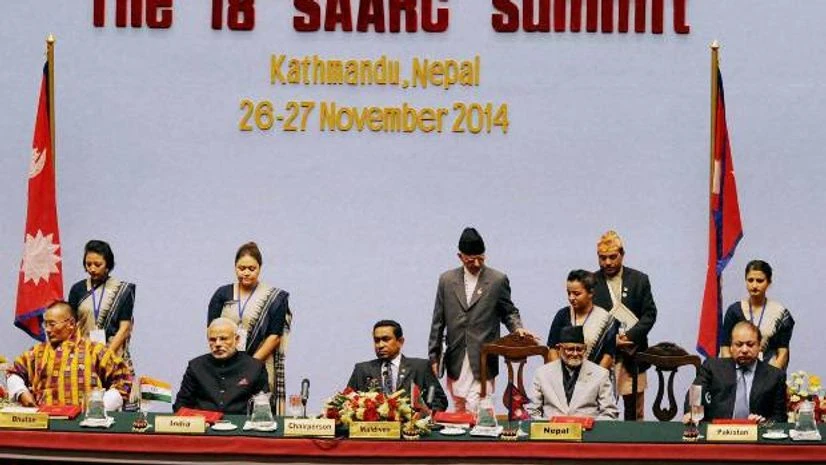It was a picture that could have launched a thousand warships. Frozen in the cameras at the South Asian Association for Regional Cooperation (Saarc) summit in Kathmandu earlier this week were images of a visibly tense Nawaz Sharif striding to the lectern to speak, even as a grim-looking Narendra Modi read a magazine, apparently uninterested in what Pakistan was about to say. The image screamed a 'breakdown' - of the Saarc summit, the possibility of a meaningful declaration emerging from it, and an easing of tension in India-Pakistan relations.
Against this backdrop, much was made of the handshake between the prime ministers of India and Pakistan on the final day of the summit, causing the Kathmandu town hall, the venue of the meeting, to break into applause.
In reality, Prime Minister Narendra Modi and his Pakistani counterpart Nawaz Sharif shook hands and exchanged pleasantries several times before this 'historic' handshake - once minutes before this picture was taken, in the holding hall, where the summit meeting was taking place and they waited for their names to be called out (in alphabetical order).
Also Read
Later, at a retreat in Dhulikhel, the two prime ministers even took a walk together and talked without aides for a considerable amount of time.
This interaction was, in part, facilitated by Nepal Prime Minister Sushil Koirala, the host for the meeting who played a big role in persuading the two leaders to talk.
From the word go, the optics that India and Pakistan tried to create was that there would be extremely limited interaction between the two nations - if there would be any at all.
Pakistan said the onus of resuming talks lay with India, as New Delhi was the one that broke those off. India said there was no proposal from Islamabad to hold a meeting, so it was unlikely the two leaders would meet.
This stand-off was reinforced at the meeting of the foreign ministers of the two countries. Three agreements were to be signed: One to create a seamless electricity grid, another to enhance road connectivity by allowing the movement of people and goods by road, and a pact to create a rail network across Saarc countries.
India said either all three would be signed, or none. Pakistan said it would sign none.
The deadlock had chairman Koirala worried. He talked to Modi and Sharif separately, emphasising the Kathmandu summit would yield no summit declaration worth its name if no agreement was signed - and the world would titter as an India-Pakistan deadlock stymied what could be one of the most powerful assemblies on the globe. Besides, there also was the question of the Nepali national pride.
Koirala's efforts met with partial success. The ice was broken at the Dhulikhel retreat the next day, when Modi and Sharif took a stroll through the extensive gardens at the resort, around what diplomats present described as a "landscaped hump". They talked without anyone else present there.
Responding to Koirala's persuasion, India agreed to sign one agreement - on energy sharing - provided transport ministers met and signed the other two within three months. Cajoled by Koirala, Pakistan agreed to the compromise as well.
Sensing a breakthrough, an elated Nepal considered requesting that all leaders come to the final meeting wearing the Nepalese national dress: The daura suruwal (a tunic and narrow trousers), to indicate everyone was on the same page.
However, logistics did not allow this: Nepal did not have all the measurements. So, the leaders were presented yellow scarves instead which they draped around their necks to signify unity. The colour was a considered choice. The meeting took place on a Thursday and Goddess Baglamukhi, the presiding goddess of Patan is believed to smiles at devotees wearing yellow on Thursdays.
Everyone was smiling on that Thursday evening. So pleased was Nepal at the outcome that a relieved government declared a public holiday on Friday.

)
